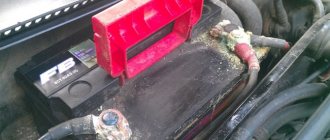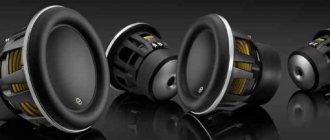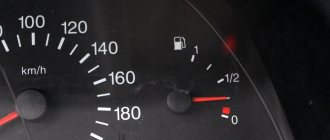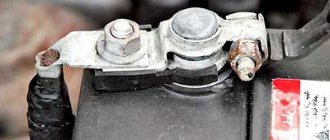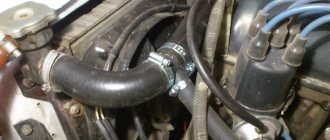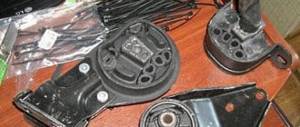Stable operation of the engine is facilitated by a properly functioning cooling system that maintains the engine temperature within the operating range. Any malfunction of the cooling system parts can cause the car engine to overheat, adversely affecting its performance and even causing it to fail - in especially severe cases.
The reasons for engine overheating can be very different. Some of them are quite trivial, others are much more serious. The problem of increased drive unit temperatures cannot be underestimated. The cause of the engine overheating must be found as soon as possible, and then everything must be done to restore it to normal.
In cases of overheating, there are two possible outcomes: the engine must be restored, or due to misalignment of the head and cylinder block, the engine assembly will have to be replaced.
Possible causes of engine overheating
When designing the engine structure, engineers take into account the fact that the unit will operate for a long time in a strictly defined temperature range. In simple words, it takes into account the fact that after starting the engine gains temperature to the operating zone, after which this range is maintained throughout the entire operation of the engine.
As a rule, in modern power units the temperature range that is considered operating varies from 85 to 110 degrees. This means that the task of the cooling system is to prevent the temperature from exceeding a given threshold.
The importance of maintaining operating temperature is explained by the fact that this contributes to a favorable engine operating mode, the ratio of operating gaps between parts, maintaining the required viscosity of the engine oil and preserving its properties.
Fuel consumption also depends on the engine temperature, since in injection engines the coolant temperature sensor is involved in mixture formation.
Coolant leak
If topping up the missing coolant does not solve the problem and the engine continues to overheat, this may indicate a leak.
An antifreeze leak leads to instant overheating, and the cooling system is filled with air, forming a plug. There are many reasons for a coolant leak:
- damage to the rubber pipe,
- radiator destruction,
- faulty water pump seal,
- breakdown of the cylinder head gasket,
- heat exchanger malfunction.
The situation is corrected by replacing faulty parts with new ones, and if it is impossible to replace the damaged part in time, you can use a sealant for the cooling system.
Car engine overheating due to radiator malfunctions
A defective radiator is most often responsible for loss of coolant. It should be remembered that this element of the car is located in such a way that it is constantly exposed to harmful external factors.
The most dangerous are water and salt, which can cause the radiator to leak, which usually occurs in the lower part. Fortunately, checking this fact does not require visiting a specialized center.
All you have to do is start the engine and make sure there are no stains under the front of the car. If there are any, this will indicate a hole in the radiator, which usually causes it to be replaced. If there is no stain, you need to check other components of the cooling system.
Radiator hose defects
The source of the leak can also be clearly visible radiator hoses. If they are cracked, the driver will have to replace them with new ones. It is necessary to check their condition, as well as the assembly on the connectors on which they may have been applied too loosely.
Cable clamps
The cables on the connectors are mounted using clamps. Over time, corrosion can occur so they don't hold the radiator hoses with enough strength. This may also lead to leakage.
Head connector
The plastic tip can also cause a coolant leak. Over-tightening will cause crack damage, which may lead to leakage. The damaged part should be replaced with a new one.
The engine overheats due to insufficient circulation
Often the culprit of poor circulation is contamination of the cooling jacket and radiator. This happens due to the use of low-quality fluid, which leaves sulfate deposits that block the path for coolant.
The source of the problem with increased engine temperature can also be a damaged coolant pump, which is responsible for circulating fluid in the cooling system. Pumps equipped with a plastic impeller are most susceptible to this problem.
If the water pump fails, the efficiency of the system is reduced: it may leak fluid, the pulley may jam due to the bearing, or rotate with play.
When purchasing a new non-original pump, you may notice that the impeller of the cheaper pump has a different shape, which means it will not provide working pressure to the system.
What causes underheating and overheating of the engine in winter?
Underheating and overheating of the engine in winter is just as dangerous as in summer. Winter cold is a severe test for any equipment, incl. and for the car. This is especially true for one of its main and most expensive units, because it has to work in very difficult conditions. On a frosty night, the engine cools down to -15 degrees or lower, and its operating temperature is from +90 to +15 degrees, and it also needs heat to heat the interior.
The first winter problem is underheating of the engine. Most often, the reason may be in us. We forget summer habits: sitting down, starting and driving is not an acceptable option now. The engine needs to “wake up”. For this, 5-10 minutes of quiet work is enough. Oil thickens in cold weather, so if you immediately put it under full load, problems with the engine may occur. And keep in mind - this is not a warranty case!
But it happens that the reason for engine underheating is a malfunction of the cooling system, for example, something with the thermostat. It can be defined like this. While driving, the heater begins to blow cold air into the cabin. Whose problem is this? Maybe the manufacturer?
Subject to the manufacturer's rules and requirements for operating the vehicle, in particular, the timely replacement of engine coolant, this problem falls on the shoulders of the dealer.
Now about the opposite case - engine overheating. Paradoxically, it is possible to boil in winter, just like in summer. It's all about the coolant - antifreeze or antifreeze. Given their aggressive chemical composition, they remain fluid, even in the cold.
Having found a microscopic gap in the cooling system, it begins to leak, and if this is not noticed in time, the engine will overheat and the car will stall while driving. Modern cars have a sensor, and in the event of a leak, the corresponding icon on the panel will light up. It is recommended to purchase antifreeze here in advance for any car and, if necessary, add it to the radiator.
And finally, another reason for engine overheating, which few people know about, is ineffective air cooling of the radiator. As a rule, the reason lies in accumulated dirt in the radiator honeycombs. The consequences of overheating can be very serious: deformation of the cylinder heads, formation of cracks on it, burnout of the head gasket.
Severe overheating of the engine can lead to jamming of the pistons in the cylinders, and even to the complete destruction of the entire power unit. It is for this reason that on modern “charged” cars, on-board computers display information about both the engine temperature and the oil temperature, because this is very important data. If they are not in your options, you need to monitor the temperature yourself.
Everything in the car is just like ours. For a person, 36.6 is normal. If the temperature is higher or lower, then there is definitely a problem that simply cannot be ignored.
SIMILAR ARTICLES:
How to open a car trunk if the lock is stuck
What to do if repairs are delayed?
Why you need to repair steering racks in a specialized CTO
Winter windshield problems
How to get to a tire shop if you have a punctured tire and don’t have a spare tire?
What whistles under the hood of a car?
Repairing an Infiniti - is it all that complicated?
How to choose an engine for construction equipment
When do you need to change springs on a Sobol?
The first signs of a steering problem
Why gearbox repairs should only be trusted to professionals
Why does white smoke come out of the exhaust pipe: causes and consequences
Repair and maintenance of fuel injectors
Why does the car jerk when driving?
Causes of knocking in the suspension: troubleshooting
Other problems that cause the engine to overheat
An antifreeze leak is the most common, but only one cause of engine overheating. Other items may be responsible, including the fan, thermostat, temperature sensor, coolant pump, or head gasket.
temperature sensor
Increased engine temperature may be indicated by a faulty temperature sensor, which should be checked by connecting the car to a computer or replacing it with a new part. It is worth emphasizing that the problem can be not only the sensor itself, but also the power cable.
Thermostat
The thermostat is the element responsible for maintaining the correct engine temperature. When it overheats, it's worth taking a closer look. It is not difficult. You just need to put your hand on the hose leading to the radiator.
If it is warm and stiff, then the thermostat is working properly. If the thermostat fails, you can expect two scenarios: long warm-up and overheating.
A cold pipe is a sign of jamming in the closed position, when the coolant works in a small circuit, bypassing the radiator, and accordingly, overheating is inevitable.
In this situation, the driver can only replace the thermostat and then ventilate the entire system.
Fan
It is also worth focusing on ventilation if the engine overheats during slow city driving. Most likely, the culprit is the belt that could have fallen off it. Additionally, the power cord may also be unplugged.
Cylinder head gasket
A damaged head gasket can also cause the engine to overheat. Then increased engine temperature is just one of the signs of such a failure. Other symptoms that indicate a gasket problem include white exhaust fumes and bubbles appearing in the expansion tank.
Causes of error P0217
- A leak in the cooling system, which may indicate damage or failure of the radiator, thermostat housing, radiator hoses, heater hoses, water pump, head gasket, or the engine itself
- Coolant temperature sensor malfunction
- Worn or damaged electrical wires related to the coolant temperature sensor
- Malfunction of the automatic transmission control module (PCM)
- Malfunction of the electric cooling fan or fan clutch
- Blocked radiator tubes or other cooling system components
- Thermostat stuck closed
What to do if the engine overheats
If the engine temperature indicator is approaching or is already in the red field, you must stop the vehicle in a safe place and turn off the engine. Then check the cooling system. It may turn out that overheating of the car engine is caused by a lack of refrigerant, which in this case needs to be replenished as soon as possible.
Do not forget that it is forbidden to top up when the engine is hot - you need to wait until the temperature of the internal combustion engine and the coolant itself drops. Otherwise, the driver will be subject to severe burns when opening the expansion tank.
You should also remember that you cannot add cold antifreeze to hot antifreeze - this may adversely affect its properties.
Likely consequences
To avoid major overhauls of the internal combustion engine, an engine overheating indicator with a temperature scale is specially displayed on the dashboard. When reaching 120 degrees, the motor should be turned off immediately to avoid the following consequences.
Slight overheating
Running the motor at elevated temperatures for 7 to 10 minutes is considered mild overheating. Engine parts begin to overheat due to a failure of the thermostat or fan - due to the natural thermal conductivity of metals, insufficient heat is removed.
If the fan and thermostat break down, the engine overheats, the consequences of which are as follows:
- melting of the pistons - 90% of modern internal combustion engines, in principle, can easily “survive” this trouble, however, the melted metal can cause scuffing on the surface of the cylinder bore;
- smoke coming from under the hood - diagnostics required at a service station.
You should not drive with a light on the dashboard (heating up to 120 degrees, “check” or low oil pressure) for longer than the specified period, as this will sharply worsen the condition of the piston group parts.
Severe overheating
If the internal combustion engine overheats in operating mode for more than 20 minutes, the following malfunctions may be added to the above consequences:
- changing the geometry of the cylinder head (cylinder head);
- opening of cracks inside the cylinder head;
- burnout of the cylinder head gasket;
- loosening and tearing of the valve seat from its seat;
- destruction of the partitions on the piston between the oil scraper and compression rings;
- leakage of lubricant through the seals;
- curvature of the landing plane of the block for the cylinder head;
- jamming of the motor or the occurrence of a characteristic knock, indicating an imminent jamming.
In this option, car repairs are very expensive, since all parts must be replaced:
- the pistons begin to burn in the combustion chamber, holes appear in them and metal destruction is observed;
- aluminum sticks to the inner walls of the cylinders;
- At high temperatures, the lubricant becomes excessively thin and loses its effectiveness;
- connecting rod and main bearings stick to the crankshaft;
- The crankshaft is the first to not withstand high-temperature heating, then the piston breaks;
- the upper part of the piston gets stuck tightly in the liner, the lower part flies into the sump.
And finally, the connecting rod, which is not held back by anything, complete with a piston pin, pierces the wall of the cylinder block in an arbitrary place. In this case, the engine stalls completely, if this does not happen at any of the indicated stages of global destruction of the unit.
In this case, the car engine cannot be repaired, so it is better not to allow the lamp to light up at 120 degrees. What to do if the engine overheats? It is important not to let the internal combustion engine overheat for a long time; you need to turn off the ignition immediately, observing traffic regulations on the road.
